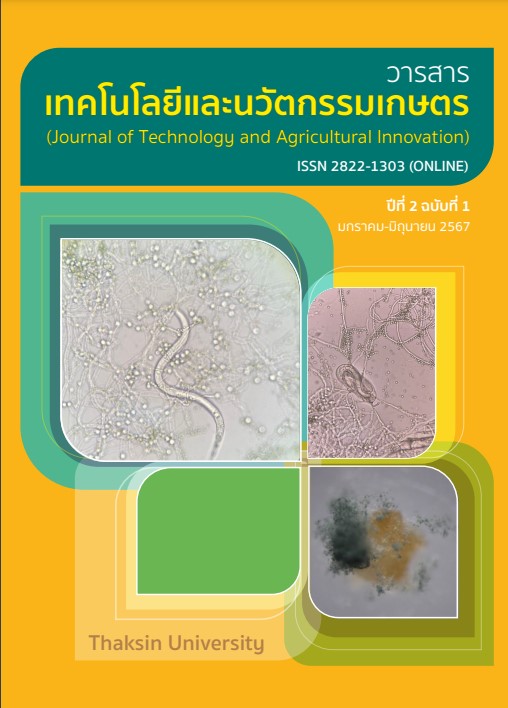Use of Bio-products and Biomass on Okra Production in Good Agricultural Practices on Clay - Clay Loam Soils, Suphanburi Province
DOI:
https://doi.org/10.55164/jtai.v2i1.773Keywords:
Okra, Bio-products, Okra, Bio-products, Biomass, Good Agricultural Practice (GAP), Good Agricultural Practice (GAP)Abstract
The management of plant nutrients is crucial for the production of okra in terms of growth, quantity, and quality of the yield. Utilizing bio-products with biomass on okra production following Good Agricultural Practices (GAP) on clay-clay loam soils in Suphan Buri province is aimed to study plant nutrient management for okra production. The experiment was conducted in a farmer's field in
Sa Yai Som sub-district, U Thong district, Suphan Buri province. The randomized complete block design
with four replications consisting of 7 treatments. These were: 1) Control 2) Chemical fertilizer application
of 18-4-6 kg/rai of N-P2O5-K2O 3) Chemical fertilizer application of 18-4-6 kg/rai N-P2O5-K2O + cow
manure 1 ton/rai 4) Chemical fertilizer application of 18-4-6 kg/rai of N-P2O5-K2O + cow manure 1 ton/rai + phosphate-solubilizing bacteria 3 g/plant + arbuscular mycorrhizal fungi 3 g/plant 5) Chemical fertilizer application of 13.5-3-4.5 kg/rai of N-P2O5-K2O + cow manure 1 ton/rai 6) Chemical fertilizer application of 13.5-3-4.5 kg/rai of N-P2O5-K2O + cow manure 1 ton/rai + phosphate-solubilizing bacteria 3 g/plant+ arbuscular mycorrhizal fungi 3 g/plant and 7) Cow manure 1 ton/rai+phosphate-solubilizing
bacteria 3 g/plant+arbuscular mycorrhizal fungi 3 g/plant. The results of the experiment showed that the application of chemical fertilizer of 18-4-6 kg/rai of N-P2O5-K2O + cow manure 1 ton/rai + phosphate-solubilizing bacteria 3 g/plant+arbuscular mycorrhizal fungi 3 g/plant resulted in the tallest okra plants at 45 and 60 days of age, reaching heights of 54.98 and 84.68 centimeters respectively,
the maximum yield of okra is 1,303 kilograms per rai, with a net profit of 6,706.00 baht per rai.
References
กรมวิชาการเกษตร. (2567). Gap online: กระเจี๊ยบเขียว. https://gap.doa.go.th/.
กรมส่งเสริมการเกษตร. (2551). คู่มือนักวิชาการส่งเสริมการเกษตร: กระเจี๊ยบเขียว. http://www.agriman.doae.go.th/
home/t.n/t.n1/5vagetable_Requirement/03_Okra.pdf.
กลุ่มงานวิจัยจุลินทรีย์ดิน. (2564). ปุ๋ยชีวภาพ. กรุงเทพมหานคร. กรมวิชาการเกษตร กระทรวงเกษตรและสหกรณ์.
กลุ่มงานวิจัยเคมีดิน. (2544). คู่มือการวิเคราะห์ดินและพืช. กลุ่มงานวิจัยเคมีดิน กองปฐพีวิทยา กรมวิชาการเกษตร.
โรงพิมพ์ชุมนุมสหกรณ์การเกษตรแห่งประเทศไทย จำกัด : กรุงเทพฯ.
กลุ่มวิจัยเกษตรเคมี. (2551). คู่มือวิธีวิเคราะห์ปุ๋ยอินทรีย์. กลุ่มวิจัยเกษตรเคมี สำนักวิจัยพัฒนาปัจจัยการผลิต
ทางการเกษตร กรมวิชาการเกษตร กระทรวงเกษตรและสหกรณ์. ควิกปริ๊นท์ ออฟเซ็ท : กรุงเทพฯ.
คณาจารย์ภาควิชาปฐพีวิทยา. (2554). ปฐพีวิทยาเบื้องต้น. พิมพ์ครั้งที่ 9. กรุงเทพมหานคร. สำนักพิมพ์มหาวิทยาลัยเ
กษตรศาตร์.
จักรพงษ์ เจิมศิริ. (2546). วิธีวิเคราะห์สมบัติทางกายภาพของดิน. กลุ่มวิจัยปฐพีวิทยา สำนักวิจัยพัฒนาปัจจัยการผลิตทาง
การเกษตร กรมวิชาการเกษตร กระทรวงเกษตรและสหกรณ์.
ประกาศกรมวิชาการเกษตร. (2555). เรื่อง การขอขึ้นทะเบียน การออกใบสำคัญการขึ้นทะเบียน การขอแก้ไขรายการ
ทะเบียน และการแก้ไขรายการทะเบียนปุ๋ยอินทรีย์ พ.ศ. 2555. https://www.doa.go.th/ard/wp-content/
uploads/2019/11/FEDOA5.pdf.
ทิพวรรณ แก้วหนู ศุภกาญจน์ ล้วนมณี ศิริลักษณ์ แก้วสุรลิขิต วนิดา โนบรรเทา สมฤทัย ตันเจริญ ชัชธนพร เกื้อหนุน
นิศารัตน์ ทวีนุต ศรีสุดา รื่นเจริญ ศราริน กลิ่นโพธิ์กลับ แววตา พลกุล ปฏิมาภรณ์ จินจาคาม กมลชนก เจริญศรี
นุชนาฏ ตันวรรณ สายน้ำ อุดพ้วย ภิญญาลักษณ์ รัตนวิระกุล และ อนุรักษ์ ภู่ระหงษ์. (2567). การประเมินการ
ปลดปล่อยไนโตรเจนของปุ๋ยหมัก มูลไก่แกลบ มูลวัวนม และแหนแดงแห้ง. แก่นเกษตร. (52)(ฉบับเพิ่มเติม 1),
-400.
สำนักงานปลัดกระทรวงพาณิชย์. (2566). ตลาดส่งออกสำคัญของไทยรายสินค้า.https://tradereport.moc.go.th/Report/
Default.aspx?Report=MenucomTopNRecode&Option=3&Lang=Th&ImExType=1.
สำนักงานเศรษฐกิจการเกษตร. (2566). กระเจี๊ยบเขียว: เนื้อที่เพาะปลูก เนื้อที่เก็บเกี่ยว ผลผลิต และผลผลิตต่อไร่ปี2565.
https://www.oae.go.th/assets/portals/1/fileups/prcaidata/files/green%20bean%20%E0%B8%9B%
E0%B8%B5%2065.pdf.
Agribot. (2004). Nutrient Management in Okra. https://agri.bot/docs/nutrient-management-in-okra/.
Pervaiz Z., Hussain K., Kazmi S.S.H. and Gill K.H. (2004). Agronomic efficiency of different N:P ratios in
rain fed wheat. International Journal of Agriculture & Biology 6(3): 455–457.
Premsekhar, M. and Rajashree, V. (2009). Influence of organic manure on growth, yield and quality of
okra. American Eurasian Journal of Sustainable Agriculture, 3(1): 6 – 8.
Walkley, A and Black. I. A. (1947). Chromic acid titration method for determination of soil organic
matter. Soil Sci. Amer. Proc, 63, 257.
Downloads
Published
How to Cite
Issue
Section
License
Copyright (c) 2024 Thaksin University

This work is licensed under a Creative Commons Attribution-NonCommercial-NoDerivatives 4.0 International License.


